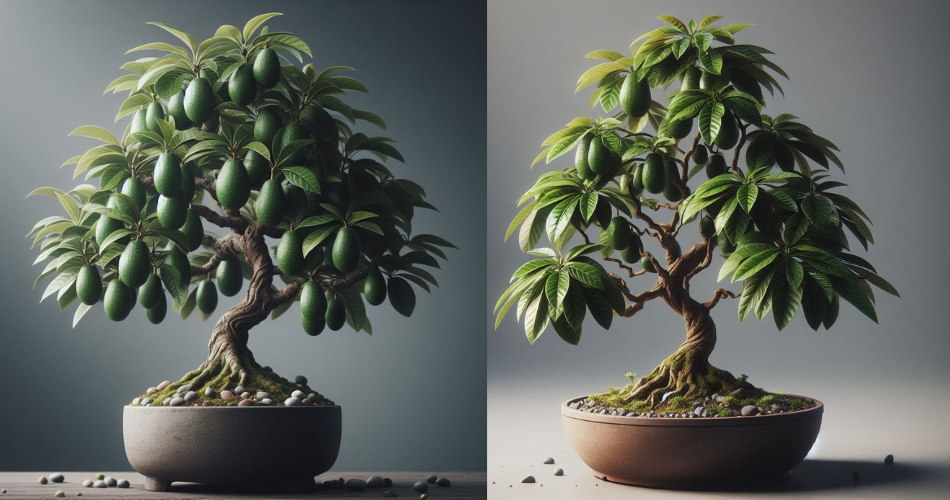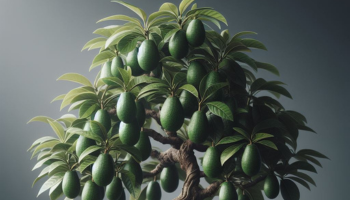
If you’re a plant enthusiast and looking for a unique addition to your indoor garden, growing your own avocado bonsai tree might be just what you need. Not only does it add life and beauty to your space, but it’s also a fun and rewarding experience.
Cultivating an avocado bonsai tree at home requires some patience and dedication but is relatively easy once you know the steps. In this article, I will guide you through the process of growing and caring for your own avocado bonsai tree.
Key Takeaways:
- Growing an avocado bonsai tree is a fun and rewarding experience.
- It requires patience and dedication but is relatively easy once you know the steps.
- Cultivating an avocado bonsai tree at home allows you to enjoy the beauty of this miniature tree in your own space.
- Choosing the right avocado variety is crucial for successful bonsai cultivation.
- Proper care, including watering and pruning, is necessary for the healthy growth of the plant.
Choosing the Right Avocado Variety for Bonsai
Avocados are a popular fruit, but not all of them are well-suited for bonsai cultivation. It’s important to choose the right variety that can thrive in a miniature environment.
When selecting an avocado bonsai tree, consider the size of the tree’s leaves. Generally, smaller leaves lend themselves better to bonsai pruning and shaping. Some recommended varieties for avocado bonsai include:
- Hass: A popular variety with small, dark green leaves and a compact growth habit. It also produces delicious fruit.
- Fuerte: Another popular variety with medium-sized, oval leaves. It’s a hardy tree that can adapt well to different growing conditions.
- Bacon: This variety has a unique growth habit that lends itself well to bonsai cultivation. Its leaves are slightly larger than other varieties but can still be pruned and shaped effectively.
It’s also important to consider the climate in which the avocado variety will be grown. Some varieties may not do well in colder temperatures or high humidity.
By selecting the right avocado variety, you’ll increase your chances of successfully growing a healthy and beautiful bonsai tree.
Planting and Caring for Your Avocado Bonsai Tree
Now that you have selected the right avocado variety, it’s time to plant and care for your bonsai tree. Follow these step-by-step instructions to ensure healthy growth:
Planting
Choose a pot that’s at least 8 inches in diameter and filled with well-draining soil. Plant your tree in the soil, making sure the root ball is level with the soil surface. Water the soil thoroughly.
Pruning
Trim back the top of your tree to just above a leaf bud. This will encourage bushier, fuller growth. Trim back any branches that grow too long or cross over other branches.
Watering
Water your avocado bonsai tree regularly, but avoid overwatering. Check the moisture level of the soil using a moisture meter and water when the top inch feels dry.
Maintenance Tips
Avocado bonsai trees thrive in bright, indirect sunlight. Place your tree near a sunny window and rotate it every few days to ensure even growth. Fertilize your tree with a balanced houseplant fertilizer every two to three months.
With these tips, you can maintain a healthy and thriving avocado bonsai tree. Keep monitoring your tree’s growth and adjust your care as necessary.
Troubleshooting Common Issues with Avocado Bonsai Trees
Despite your best efforts, your avocado bonsai tree may run into some common issues. Pests, diseases, and nutrient deficiencies can all affect the health and growth of your plant. It’s important to identify these problems early and take appropriate measures to address them.
Common Problems
Here are some of the most common issues you may encounter with your avocado bonsai:
- Yellowing leaves: This can be a sign of nutrient deficiency or overwatering.
- Brown spots: This could be due to fungal diseases or pests.
- Pest infestation: Spider mites and thrips are common pests that can affect avocado bonsai trees.
Troubleshooting Tips
If you notice any of these issues, here are some troubleshooting tips to help you get your avocado bonsai tree back on the right track:
- Check soil moisture: Make sure you’re not overwatering your tree and that the soil isn’t too dry.
- Nutrient deficiency: Use a fertilizer specifically designed for avocado trees or try adding an organic compost to the soil.
- Pest control: Use an insecticidal soap or neem oil to control pests.
- Disease control: Remove affected leaves or branches and use a fungicide to control fungal diseases.
By following these tips, you’ll be able to troubleshoot and resolve common issues with your avocado bonsai tree.
Conclusion
In conclusion, growing an avocado bonsai tree can be a delightful and engaging activity for any plant enthusiast. By following the steps and techniques outlined in this article, you can successfully cultivate your own homegrown avocado bonsai tree. Remember to carefully choose the right avocado variety for bonsai, provide the necessary care and maintenance, and troubleshoot any potential issues that may arise.
With patience and dedication, you can watch your avocado bonsai tree grow and transform into a stunning miniature tree that adds life and vibrancy to any space in your home. So why wait? Start your avocado bonsai journey today and enjoy the beauty of this fascinating plant!
FAQ
How long does it take for an avocado bonsai tree to grow?
The growth rate of an avocado bonsai tree can vary depending on various factors such as the variety, growing conditions, and care provided. On average, it takes about 3-5 years for an avocado bonsai tree to grow and develop into a mature tree.
What are the best avocado varieties for bonsai?
Some recommended avocado varieties for bonsai cultivation include ‘Hass,’ ‘Bacon,’ ‘Fuerte,’ and ‘Reed.’ These varieties are known for their compact growth habit and adaptability to bonsai techniques.
How often should I water my avocado bonsai tree?
The watering frequency for an avocado bonsai tree depends on environmental conditions, such as temperature and humidity. Generally, it’s best to water the tree when the top inch of soil feels dry. Avoid overwatering, as it can lead to root rot. Regularly monitor the moisture levels and adjust the watering schedule accordingly.
What should I do if my avocado bonsai tree is infested with pests?
If you notice pests on your avocado bonsai tree, such as aphids or spider mites, it’s essential to take immediate action. Begin by manually removing the pests using a soft brush or cloth. If the infestation persists, you can use organic pest control methods or consult a professional for guidance.
What are some common issues that avocado bonsai trees may face?
Avocado bonsai trees may encounter several common issues, including leaf browning, wilting, and yellowing leaves. These problems can be caused by factors such as overwatering, inadequate sunlight, nutrient deficiencies, or pests. Proper care, regular monitoring, and timely intervention can help address and prevent these issues.

